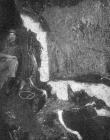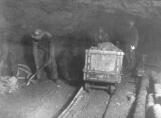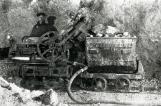1
Historical Records - Underground ViewsThe record of underground work by miners is sparse and pictures depicting the early days are few. Conditions were not conducive to photographer or photography due to high humidity, dust and smoke from explosives. The darkness of the mine, the need for long exposures, and the difficulty of access were additional obstacles. It has been said that miners were not aware of the size of some of the workings due to the poor light conditions that they worked in. The few photographs that were made revealed an interesting but difficult work environment.
NOTE:
Click on the picture to see an enlarged view of any picture throughout the exhibit.
3
Underground VisitorsVisitors were welcome in most of the mines to see how the silver was mined and also possibly investments in the various properties. Cobalt was as close as a train ride from Union Station in Toronto. The train stopped in Cobalt in the middle of the mining action! Special clothing and safety equipment were not very high on the list of requirements for an underground visit. Children would frequently use the mines as a playground visiting through the open cuts that were throughout the town and rarely fenced off.
4
Underground Vein, Kerr Lake1910
Cobalt Mining Camp, Town of Cobalt and Coleman Township, Ontario, Canada

5
Underground Vein, Kerr LakeThe picture illustrates a silver vein at the Kerr Lake mine. The miners would tunnel along through the rock keeping the vein in the tunnel face ahead of themselves. This enabled them to find out how long the vein was and also the values that it contained.
6
Underground Vein, Larose Mine1907
Cobalt Mining Camp, Town of Cobalt and Coleman Township, Ontario, Canada

7
Underground Vein, Larose MineVeins underground were different widths and grades varying with the silver content. Veins only an inch wide could be worth thousands of dollars per ton whereas others two or three feet wide may only be a hundred dollars per ton, but still worth mining. Notice that candles were the light source.
8
Drift Drilling, LaRose Mine1908
Cobalt Mining Camp, Town of Cobalt and Coleman Township, Ontario, Canada

9
Drift Drilling, LaRose MineTunneling was done by drilling with Leyner drills. These were very heavy drills mounted on a bar that was wedged between the walls. The driller is standing on the bar in this picture.
10
Diamond Drill, LaRose Mine1908
Cobalt Mining Camp, Town of Cobalt and Coleman Township, Ontario, Canada

11
Diamond Drill, LaRose MineDiamond drills were used underground as well as on surface to locate veins at depth and also seek parallel vein systems. It was a cheaper method of exploration rather than tunneling or doing additional shaft sinking until warranted.
12
Mucking, LaRose Mine1908
Cobalt Mining Camp, Town of Cobalt and Coleman Township, Ontario, Canada

13
Mucking, LaRose MineUntil the advent of mechanical devices for picking up rock all the ore had to be hand mucked by shovel into the cars. The cars held approximately one ton when filled and were then pushed by hand to the disposal point at the shaft or the adit entrance.

